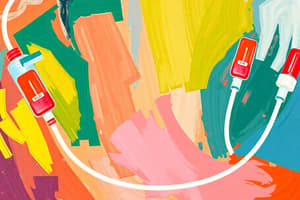Podcast
Questions and Answers
What should be monitored to minimize the risk for skin breakdown in patients?
What should be monitored to minimize the risk for skin breakdown in patients?
- Dietary fiber
- Skin hydration
- Catheter maintenance (correct)
- Fluid intake
What type of catheter is described as having straight tubing that is removed after use?
What type of catheter is described as having straight tubing that is removed after use?
- Suprapubic catheter
- Foley catheter
- Stoma catheter
- Intermittent catheter (correct)
Which factor can lead to retention issues in older adults?
Which factor can lead to retention issues in older adults?
- High dietary fiber
- Regular exercise
- Neurological changes (correct)
- Increased water intake
What is a possible consequence of using a Foley bag?
What is a possible consequence of using a Foley bag?
Which type of stool formation is characterized by being the least formed?
Which type of stool formation is characterized by being the least formed?
What can be a possible effect of chewing movements in relation to digestion?
What can be a possible effect of chewing movements in relation to digestion?
What is a significant factor to keep in mind when managing patients with a stoma?
What is a significant factor to keep in mind when managing patients with a stoma?
What is a higher risk associated with using a Foley bag?
What is a higher risk associated with using a Foley bag?
What is a primary characteristic of stool that is classified as liquidy?
What is a primary characteristic of stool that is classified as liquidy?
What is a common reason for stool to become looser?
What is a common reason for stool to become looser?
In older adults, what type of changes may lead to retention issues?
In older adults, what type of changes may lead to retention issues?
What is a potential outcome of excessive chewing movements during meals?
What is a potential outcome of excessive chewing movements during meals?
What can contribute to a higher risk of catheter-related issues in patients?
What can contribute to a higher risk of catheter-related issues in patients?
What is the primary function of straight tubing in a urinary catheter?
What is the primary function of straight tubing in a urinary catheter?
Flashcards are hidden until you start studying
Study Notes
Retention Issues
- Retention issues in older adults may happen due to neurological changes
- Not everyone experiences retention issues
- Retention may be indicated by the need for frequent urination
Catheter
- A urine catheter is placed through the stoma
- A Foley catheter is a type of urinary catheter
- The Foley catheter is placed in the bladder and has a balloon that inflates to help secure the catheter
Stoma Care
- The stoma should be kept dry and clean to avoid infection
- A large tube may be needed for urination
- The large tube may be called a "big tubing"
Bowel Management
- A big tube, such as a Foley catheter, increases the risk of infection
- The Foley catheter is placed in the bladder through the stoma
- A urinary catheter is inserted into the urethra, usually to help drain urine from the body
- Bowel movements involve the movement of material in the intestines
- Diarrhea can be caused by frequent bowel movements
- Diarrhea can lead to dehydration and skin breakdown
- Enemas can be used to help with bowel movement
Post-Operative Care
- Post-operative care involves managing pain with drugs or methods including ice packs
- Refusing to eat after surgery can lead to infection, and may be a sign of discomfort or illness.
- Rocking back and forth may be a sign of discomfort or illness.
Other Concerns
- Older adults are at risk for skin breakdown due to a variety of factors, such as frailty and immobility.
- The use of a Foley catheter increases the risk of injury or infection
- The use of a Foley catheter increases the risk of skin breakdown
General Points
- The text discusses a variety of topics about older adults and their healthcare needs
- The text is written in fragmented sentences and uses abbreviations and misspellings.
Urinary Catheter Related Issues
- Potential for skin breakdown due to the catheter
- Catheter can be a source of infection
- Urinary retention issues are common
- In older adults, neurological changes related to urinary function might occur
Stoma and Catheter
- Ynimiskhadder catheter is placed in the stoma
- Urine exits through the stoma
- Straight tubing is removed after the procedure
- Large tubing is used after removal of the straight tubing
- Higher risk of infection when using a Foley bag
Postoperative Considerations
- Potential for constipation following surgery
- Diarrhea can be caused by chewing movements
- Enemas can be used to manage bowel movements
- Stool consistency can vary from liquid to formed
- Encourage hydration by providing fluids
Other Notes
- The text refers to "Mcsifiction" but provides no further details
- The text mentions "fi'stofigurine" and "Jurine" but these terms are not defined
- The terms "abused from catheter" and "Ibefrom" are unclear and require further clarification
- The text uses a combination of uppercase and lowercase letters, creating difficulty for the reader.
Studying That Suits You
Use AI to generate personalized quizzes and flashcards to suit your learning preferences.




